The Moon, Mars and Beyond: The Tech Behind the New Space Race
The summer of 2022 saw the 50 year ceremony of the Apollo 11 mission, when humans first walked on the surface of the Moon. Engineering science and technology surged alee, thanks to a two horse race between USA and the Soviet Union, where the latter seemingly had the pb in every area. That battle was fueled by suspicion, fear, and a drive to exist 'better' than the other country. Just like all sprints for the finish line, the pace couldn't last and the urgency soon passed. But at present there is a new race -- non of countries, but one fought by companies. Capitalism, growth, and business concern opportunities are the new fuels, and the goals are even bigger: not just dorsum to the Moon, but on to Mars and beyond.
A epitomize of the terminal space race
What exactly is a 'space race' though? In this day and age, rocket launches, carrying satellites into space, take place about 200 times every yr and multiple spacecraft operate on or around other planets in our solar system. So the notion of having a race in or to space might seem rather odd, simply if we get back sixty years into the past, the situation was very unlike.
In this twenty-four hour period and historic period, rocket launches, carrying satellites into space, accept identify nearly 200 times every year
Only two countries really had the adequacy of launching anything into space: the Usa of America and the Matrimony of Soviet Socialist Republics (better known every bit the Soviet Marriage). The beginning known human-made object to reach space was a High german V2 rocket, launched by Nazi Germany, in the latter days of World State of war 2, circa June 1944. There was no scientific goal behind the test; information technology was a purely armed services do, reaching an altitude of 109 miles (176 km) before falling straight dorsum to Earth.
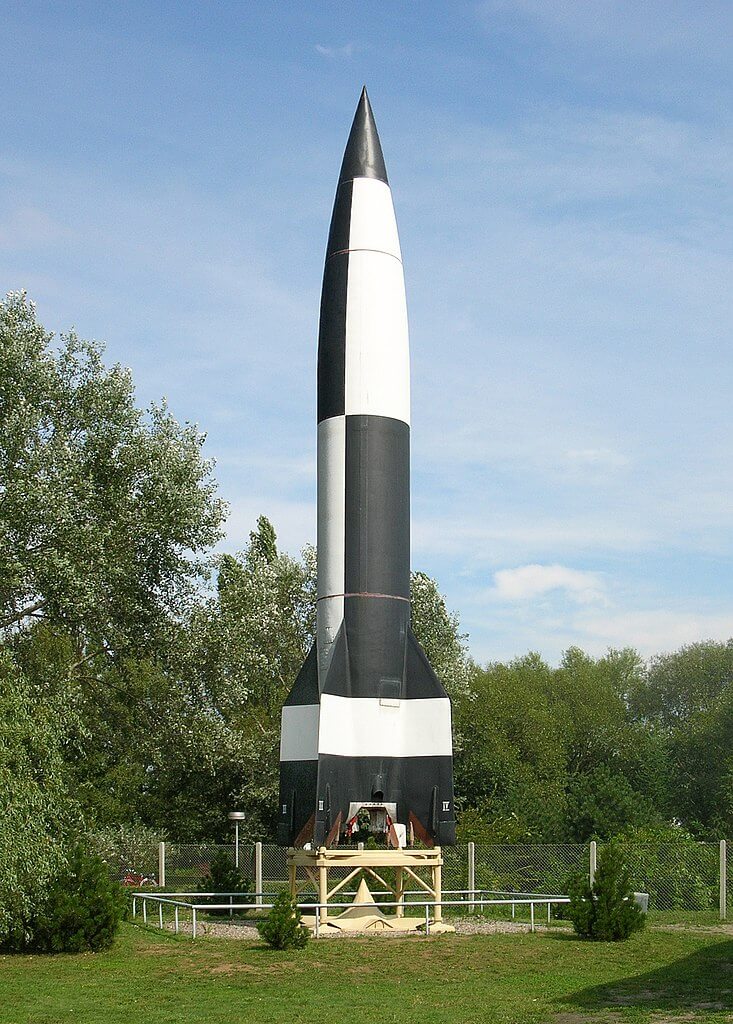
The technology behind the V2 was utilized by both the US and the Soviet Union, after they snapped upwardly scientists, engineering technicians and technical blueprints at the terminate of World War ii. The US achieved their passage into infinite using the German design with the Bumper rocket program, four years afterwards, with the USSR achieving the feat merely a few months afterwards.
A quick word, though, needs to exist said well-nigh where exactly the boundary line for infinite is. The The states Air Force and NASA, for example, both set this at an distance of 50 miles (80.v km), whereas the FAI (a global organisation that records feats in air and spaceflight) uses Theodore von Kármán's theoretical definition for the outset of space, around 62 miles (100 km). At either altitude, the atmospheric density is very low: 99% of the Earth's atmosphere is beneath this region, so winged flight is essentially impossible.
Just getting to space wasn't the main involvement of the ii countries, as they were aiming to reach orbit. With this, they could identify objects that could rapidly circumnavigate the planet, out of reach of whatsoever fighter plane, to accept images or evangelize a weaponized payload. In other words, it was a armed services race and by the 1950s, conflicts in Korea and Vietnam, forth with a huge growth in nuclear weapon testing and increased political tensions between the USA and USSR, drove a desperate urgency into the race.
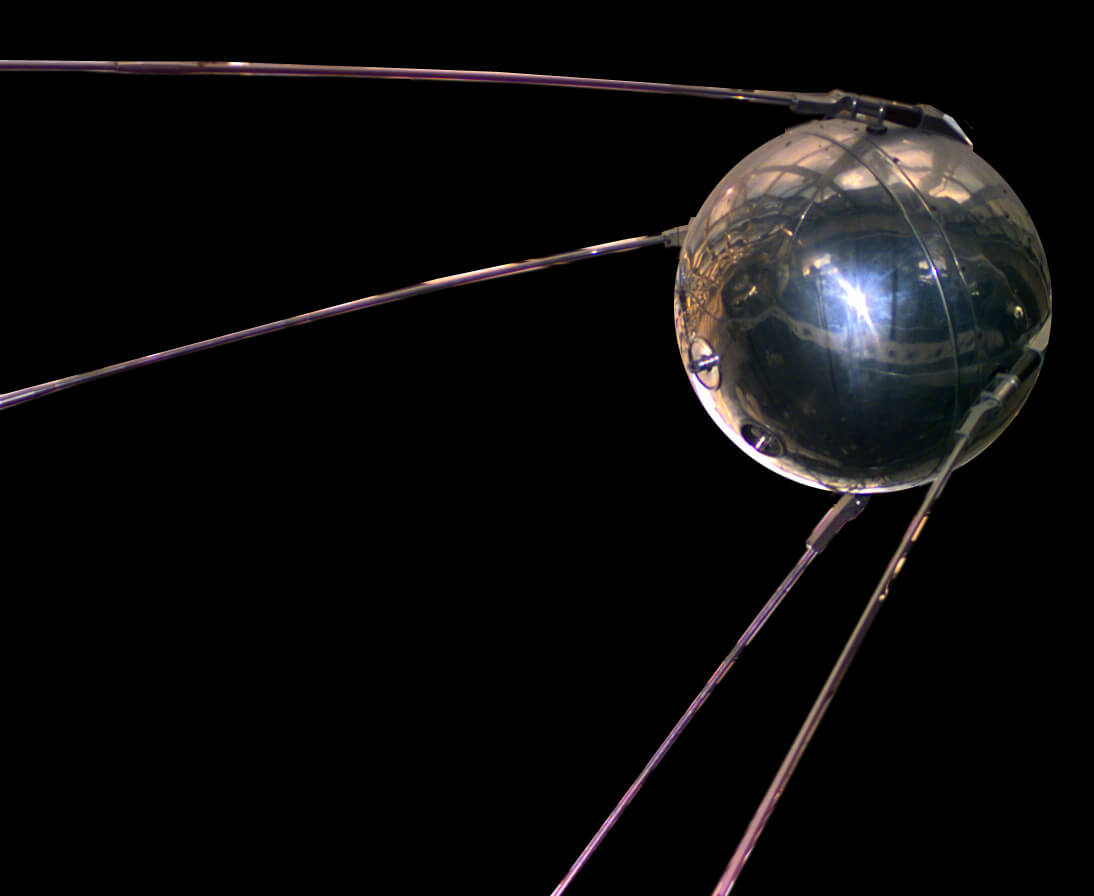
The critical turning point in all of this was the USSR's launch of Sputnik 1 - the first bogus object to consummate a full of orbit of our planet. It actually did over a thousand orbits, before atmospheric drag brought it back down, but for 3 weeks, the 180 lb (85 kg) satellite emitted a unproblematic radio indicate, telling the world 'here I am'.
The infinite race had truly begun.
The Soviet Union then went on to achieve a number of sizable 'firsts':
- First brute in orbit - Laika in Sputnik 2 (and what a miserable story that was)
- Showtime artificial object to reach the Moon - Luna two in 1959
- First man in orbit - Yuri Gagarin
- Starting time adult female in orbit - Valentina Tereshkova
- First 'walk' in infinite - Alexei Leonov
Now it might seem that America was simply sitting back and letting someone else accept all the glory, just in a similar period of time (the 1960s), they developed the showtime solar powered satellites; the starting time communications, satnav, and weather condition satellites; they also reached Mars first (USSR reached Venus a few year beforehand) and carried out the kickoff orbital rendezous and docking.
The true finishing line for the showtime space race was arguably the Moon, though. When the Soviets reached our natural satellite (and past reached, nosotros mean impacted at over 7000 mph), it became the obvious target to aim for, not only for armed forces reasons but for a permanent place in history. In May 1961, President John F. Kennedy delivered his famous speech to Congress, with the immortal line:
"I believe that this nation should commit itself to achieving the goal, before this decade is out, of landing a man on the moon and returning him safely to the world."
Since this was said just i month after Yuri Gagarin said 'Poyekhali!' and circled the Earth in space, it must have come across every bit being almost incommunicable to accomplish within just ix years; and yet, every bit we all know, it was achieved with five months to spare.

Thanks to that presidential goal, the drive and delivery of thousands of scientists, and a healthy stack of dollars, the Apollo space program introduced a raft of new technology developments -- notably in computing, materials, and rocket technology. And so to set the scene for this commodity on the new infinite race, let's take a quick wait at those.
The new technology of the quondam guard
The tardily 1950s and early 60s was the dawn for the digital estimator -- mechanical and analogue systems were in utilize earlier and during this era, simply they either lacked the required processing capabilities for managing a circuitous rocket organisation, were likewise fragile to be depended upon thousands of miles away in space or they were far, far too big to be used in any spacecraft.
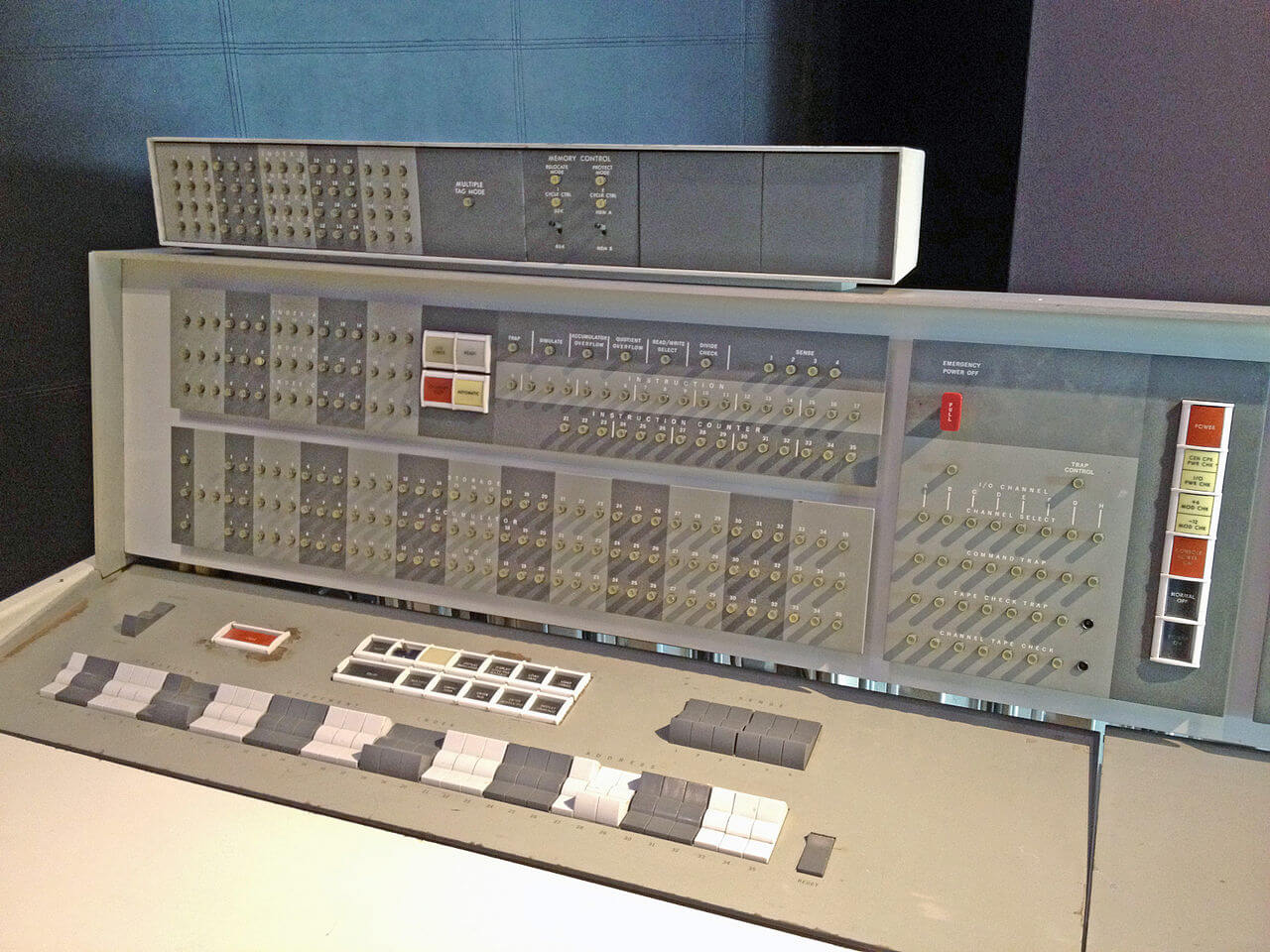
Fortunately for the Apollo program, monolithic integrated circuits (aka a chip) had been invented merely a few years earlier, and the pace of their development was such that they could be manufactured with sufficient quality and plenty quantity to exist used to form the basis of the computers to manage the guidance systems of the rocket.
In the early on to mid 1960s, researchers at the Massachusetts Institute of Engineering science, used the new invention to create a estimator that was powerful (roughly 85,000 operations per second), meaty (just 70 lbs or 32 kg in weight), and very reliable. It may seem utterly archaic by today's standards, but it was perfect for NASA's requirements and was used for nearly 10 years on multiple missions. Information technology was formally called the AGC, Apollo Guidance Computer.
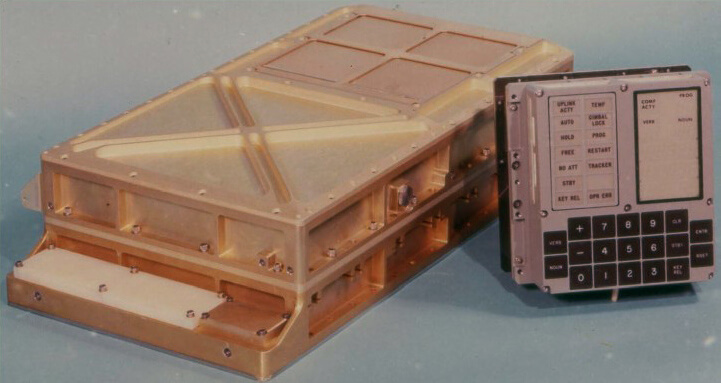
The performance and output display of the computer was handled via a split up unit, called the DSKY (brandish-and-keyboard); inputting a plan was done using but 2 commands (verb and noun), and associated numbers. This simplicity was its strength: astronauts could receive new programs from ground control, apace enter them, and not accept to worry almost the fact that they weren't cutting border computer scientists.
Multiple 'cores' aren't a new matter
All computers need retentiveness, of grade, and the AGC was no unlike - it had read-simply storage (ROM), for holding the operating software, in the course of cadre rope memory. Think of this as being like a mitt woven rug, where thousands of strands of wires are wrapped around or fed through trivial metallic loops.

These loops, chosen cores, are office of a circuit component chosen a pulse transformer and depending on how the strands were woven about the cores, the transformer would generate a null output (0) or a square wave output (ane) - i.e. each cadre was essentially 1 bit of storage.
The AGC that controlled the Apollo eleven spacecraft had 540 kilobits (36,864 sets of xvi cores - 15 for information, 1 for parity checks) of ROM and all of the software, designed by the MIT scientists, was meticulously manufactured by teams of highly skilled women at Raytheon's factories.
In improver to the ROM, the AGC too had a minor amount of re-writable storage, just 30 kilobits of magnetic-core retentivity. Similar in construction and performance to core rope memory, this bones simply dependable RAM used electromagnetic consecration within the cores to generate the 0 and 1 values for each bit.
In contrast to the cutting edge technology employed to control the flight systems on the Apollo space, the Soviet Union employed electro-mechanical systems, such as their Globus IMP navigation unit. This 'clockwork' computer was surprisingly sophisticated, and remained in utilize (albeit with significant revisions along the manner) for almost 40 years.
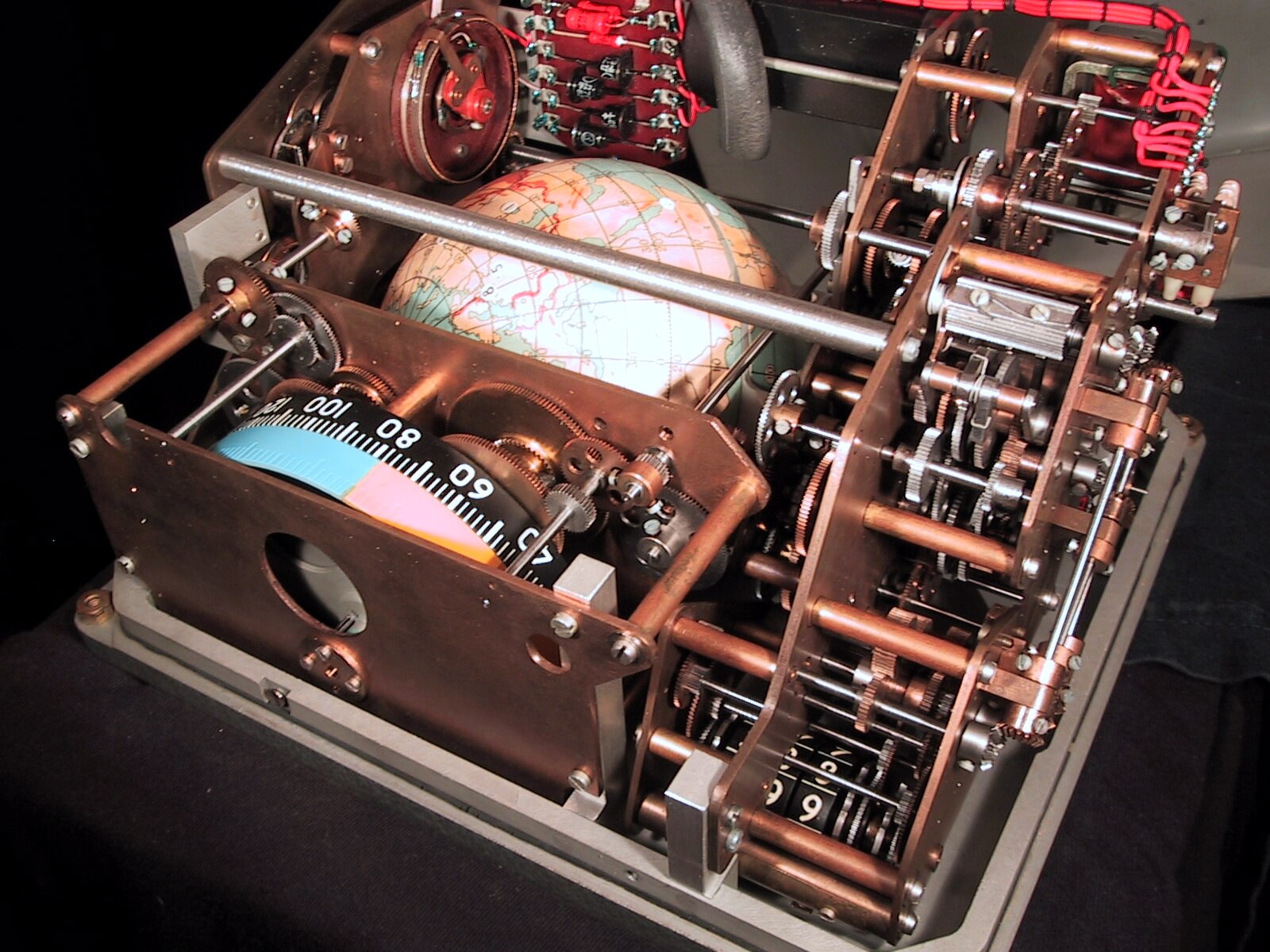
It's worth noting that, different NASA's AGC, the Globus machine did non directly control the spacecraft. Early space missions by the Soviet Union were automated and/or controlled from Earth -- the cosmonauts were literally along for the ride. However, the spacecraft simply remained in radio contact with mission control for a fairly small-scale period within each orbit, and the gear-driven Globus computer provided a robust system to help maintain correct position and provide the coiffure with the information needed to alter their position, if required.
Computers back down on Earth
The breakthrough use of computers wasn't just for controlling the rockets. Back downward on terra firma, NASA used the latest machines from IBM to process information sent dorsum from the missions and for the first landing on the Moon, it was a drove of Arrangement/360-91s that ran the number crunching.

These were truly remarkable machines - capable of handling 32 bit integer and 64 bit floating signal operations, at up to xvi million calculations per 2d, they were amidst the first machines to do deep instruction pipelining and out-of-order execution. The system memory ranged from 2 to 4 MiB in size and had multiple memory channels to meliorate read/write performance.
Ground control computers in the USSR were only equally advanced. At around the same time that NASA was employing IBM'south supercomputers to full effect in the Apollo program, the Soviet Academy of Sciences designed and congenital a machine (the BESM-half-dozen) that had a parallel instruction pipeline and 48 scrap floating point processor (integer operations were handled past the same units).
While it didn't match the System/360, in terms of clock speed and memory (address coach was merely fifteen $.25 wide, compared to IBM'due south 21 bits), it was still a very capable computer - so much and so, that they remained in employ, like so much of early Soviet technology, for nearly two decades.
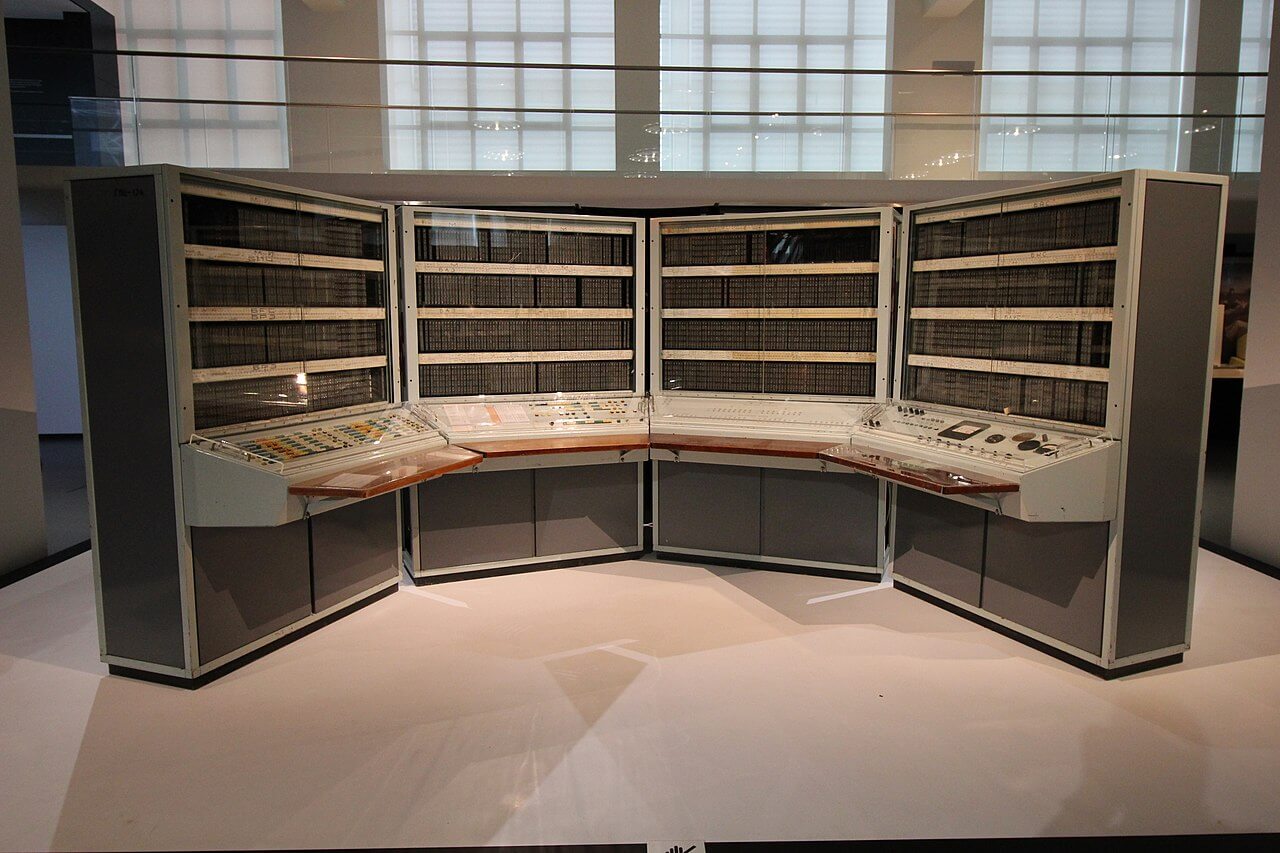
The rate of progress in computer technology relegated these machines to history in just two decades (for example, Intel's 80486 CPU released in 1989 could handle upwards to xx one thousand thousand instructions per second and address 4096 MiB of RAM), just that the fact that smartphones of today accept capabilities engineers in the 1960s could just dream of, owes no small thank you to the hectic enquiry and development past the US and the Soviet Union.
Materials for human being and machine
Digital electronics wasn't the only area that saw development and progress. To complete the viii day mission to the Moon's surface and back, the crew required 3 spacecraft and 3 rockets. In the case of the quondam, they were the:
- Apollo Command and Service Module (CSM) - this was abode for the astronauts during the flight, and also housed the hydrogen and oxygen needed for air, h2o, and electricity
- Apollo Lunar Module (LM) - the machine that took Neil and Buzz onto the Moon and back into orbit
- Apollo A7L - the cocky-independent spacesuit for walking on the Moon
It might seem a piffling odd to consider the spacesuit in the same calorie-free equally the CSM/LM, but they served a very similar function: keep the crew alive in infinite. They comprised multiple systems, with layers for cooling -- in direct sunlight, temperatures on the Moon can reach 250°F/120°C -- protection against micrometeorites and the rough lunar rocks, and a pressurized vessel to cope with the lack of temper.
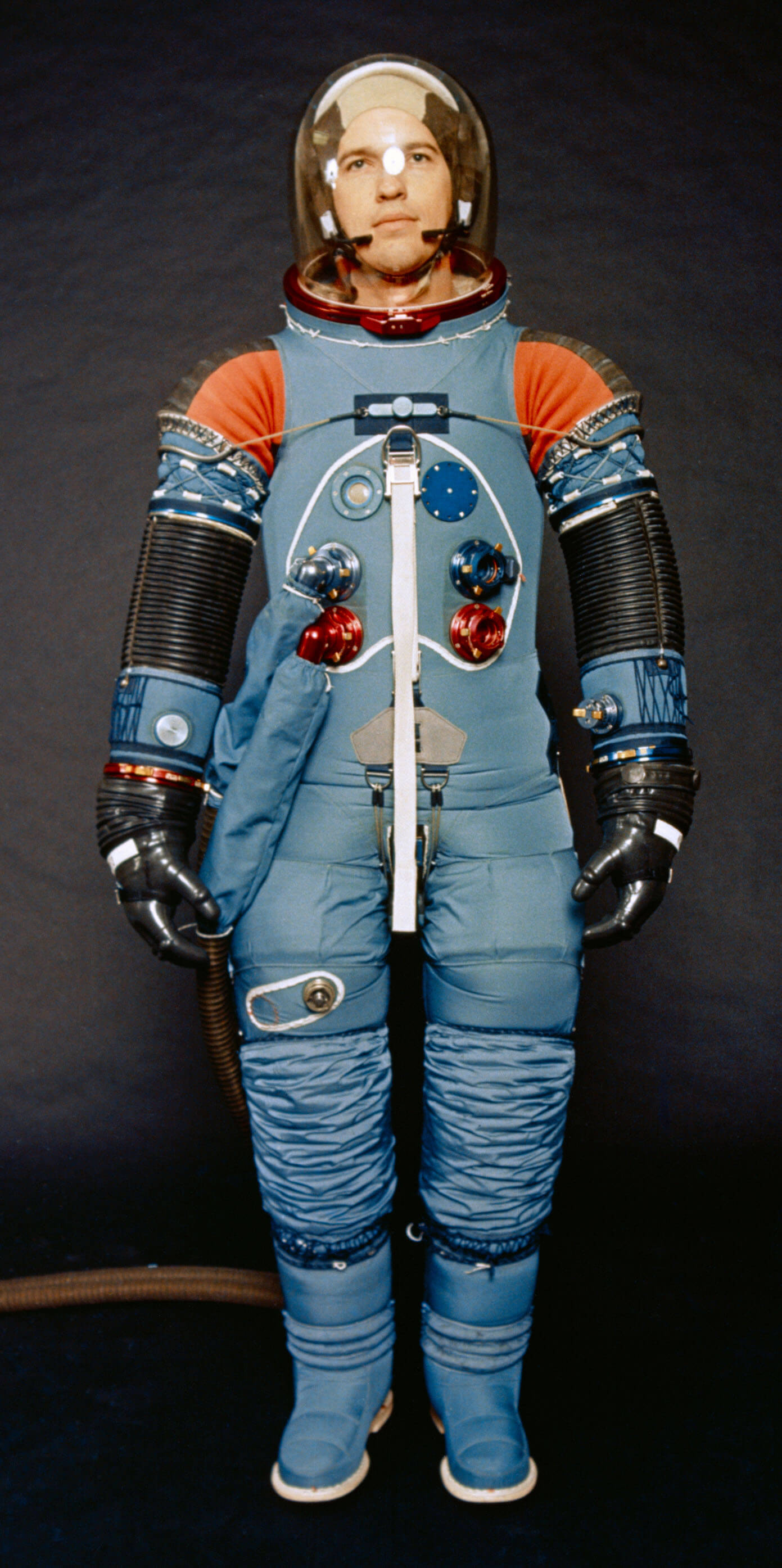
The complete suits were designed and manufactured past International Latex Corporation (ILC), a business firm who specialized in products using polymer and silica materials. The A7L used the full gamut: latex rubbers; polyethylene terephthalate fibres; polymide films; nickel and chromium alloys; polycarbonate shells; gold plated polysulfone layers.
It shouldn't come as a surprise to note that NASA and the various manufacturers went to on to form commercial agreements, many of which formed products that we know and use even today.
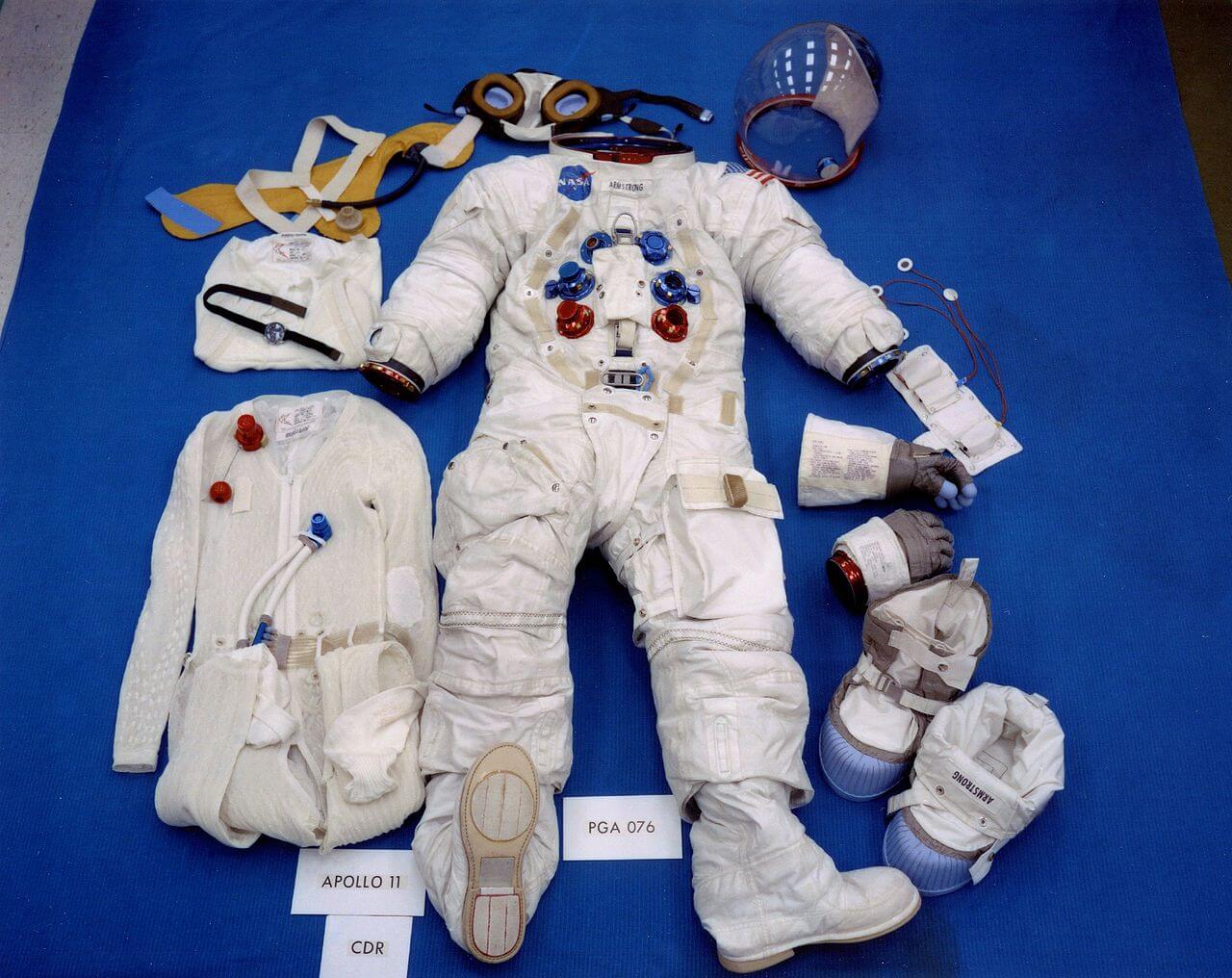
The A7L was such a success for ICL that the overall structure is still in apply, albeit heavily modified for the electric current requirements of missions on lath the International Space Station.
Specialized materials were used throughout the construction of the Saturn V rocket, too, involving a wealth of aluminum, titanium, and steel alloys. In that location were 3 stages in total: the first, using refined kerosene and liquid oxygen for fuel, would run for merely 2 minutes but information technology would be plenty to get the rocket up to a speed of five,000 mph.
The second stage was smaller and less powerful, burning through liquid hydrogen and oxygen for 6 minutes, to boost the velocity past another ten,000 mph.
The concluding stage, like to the 2d one, was used to put the rocket into Earth orbit and then once more to head off to the Moon.

Fully fueled, the entire construction weight in excess of 6 1000000 pounds (about 3,000 metric tonnes) and stood 363 feet (111 metres) tall. It nevertheless holds the record for the largest and most powerful rocket always constructed.
The vastness of the Saturn V belies the fact that weight was crucial to the operation of the Apollo program, such that the Lunar Module had a dry out mass of less than 10,000 pounds (four,500 kg) and in places, the composite materials were no thicker than the walls of a soda tin. The design criteria for safety was essentially not 'safe no matter what' but 'just brand information technology safe plenty'.
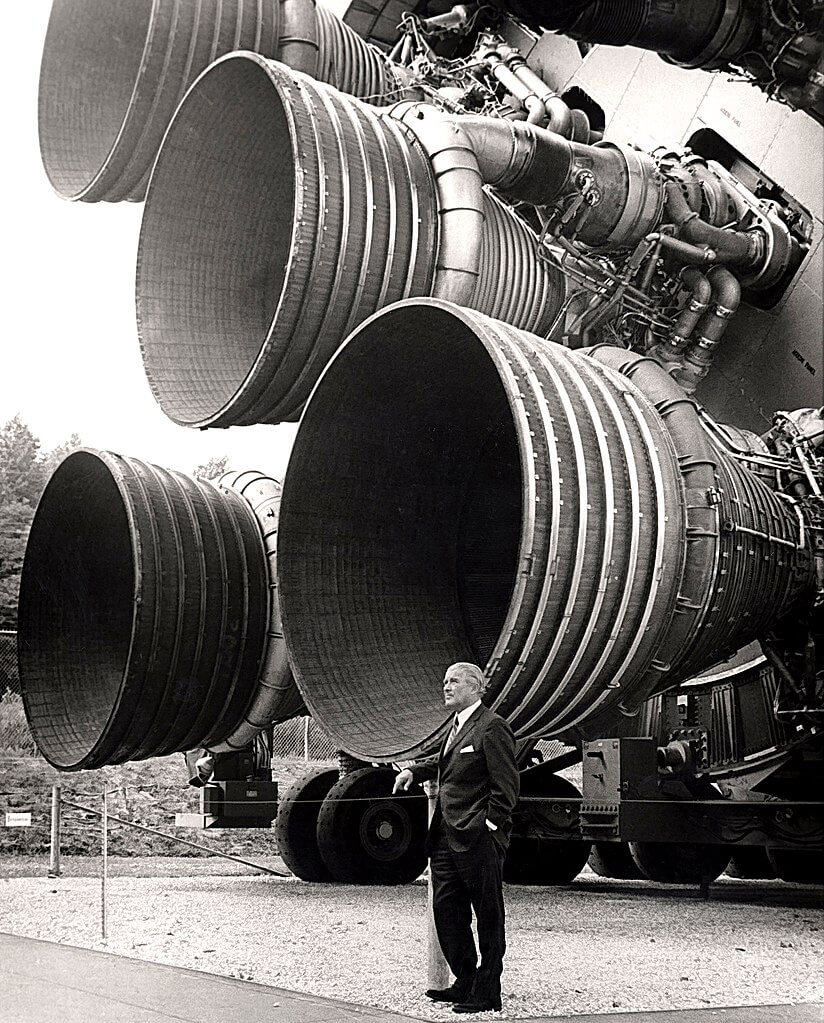
The Soviet Matrimony had besides developed a massive rocket, simply called the N1, although it wasn't quite to the same scale equally the Saturn V. The first 3 launch attempts all ended in failure and the whole project was fraught with in-fighting, battles of egos and politics, and a dearth of proper funding.
When the Apollo program came to end in 1972, USSR engineers tried in vain for a few more than years to brand a success out of the rocket just it was scrapped without fanfare by 1975.
The Moon: Too far, too expensive
Emboldened by the achievements of their engineers during the 1960s, NASA planned for multiple new programs mail service-Apollo, including permanent infinite stations and a base on the Moon, reusable vehicles and nuclear rockets, and a manned mission to Mars.
These were presented to President Nixon and his administration in the early 1970s and the decision was a clear 'no' to all bar the reusable vehicle. Any hope of returning the Moon, in an Apollo v2.0 program, was categorically shot down.
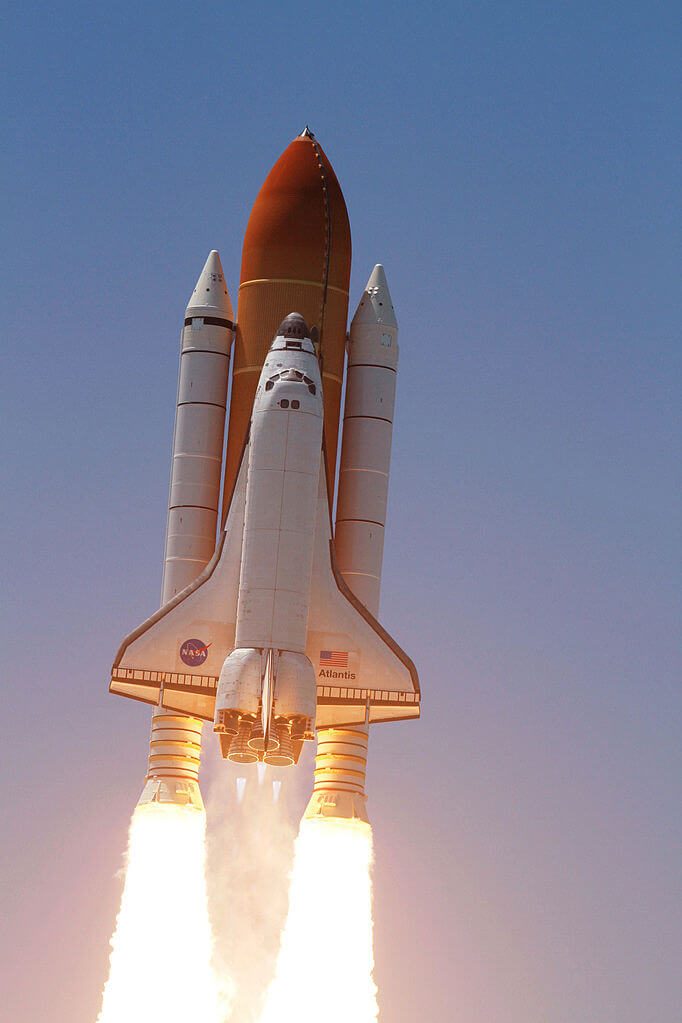
The reusable vehicle project would eventually go alee and get the Space Shuttle programme (a temporary space station was too agreed in the grade of Skylab), but one affair was clear: there would be no coin to putting humans further than Low Earth Orbit, let alone for aiming for a landing on some other torso.
The Apollo program cost 25 billion dollars by 1973 (at least 5 billion over the 1961 estimate and more than than double that of the initial projections) and took upward almost half of NASA's budget each year. To understand simply how much coin this was, consider the fact that the United states federal budget for the year that man first walked on the Moon was around 180 billion dollars.
Spending at that level was never going to be sustainable, and neither the U.s.a. nor the Soviet Wedlock could beget to tackle the dream of having humans living on the Moon or Mars. Infinite flights needed to become far more cost effective, especially compared to Apollo, where each flying mission toll in excess of 300 meg dollars, covering the arts and crafts, fuel, staffing, etc. (valuation circa 1974, $1.5 billion in 2022 dollars).
Each Saturn V rocket was substantially unique, they weren't designed to be mass-manufactured, and every one accrued numerous revisions to resolve problems experienced in previous flights. No part of the rocket was reusable either; the only role that returned to Globe was the Command Module, and they never saw service again after the mission.
NASA pinned the hopes for making spaceflight routine and profitable on the mostly reusable Infinite Shuttle (only the main orange fuel tank was wasted each flight); the Soviet Spousal relationship and so after the collapse of the old land, Russia, briefly experimented with a copy of the Shuttle (chosen the Buran), but neither met the lofty goals of having a spacecraft that could be used over and over. The failures were either due to fundamental design issues, operating costs, or a lack of funding for development.
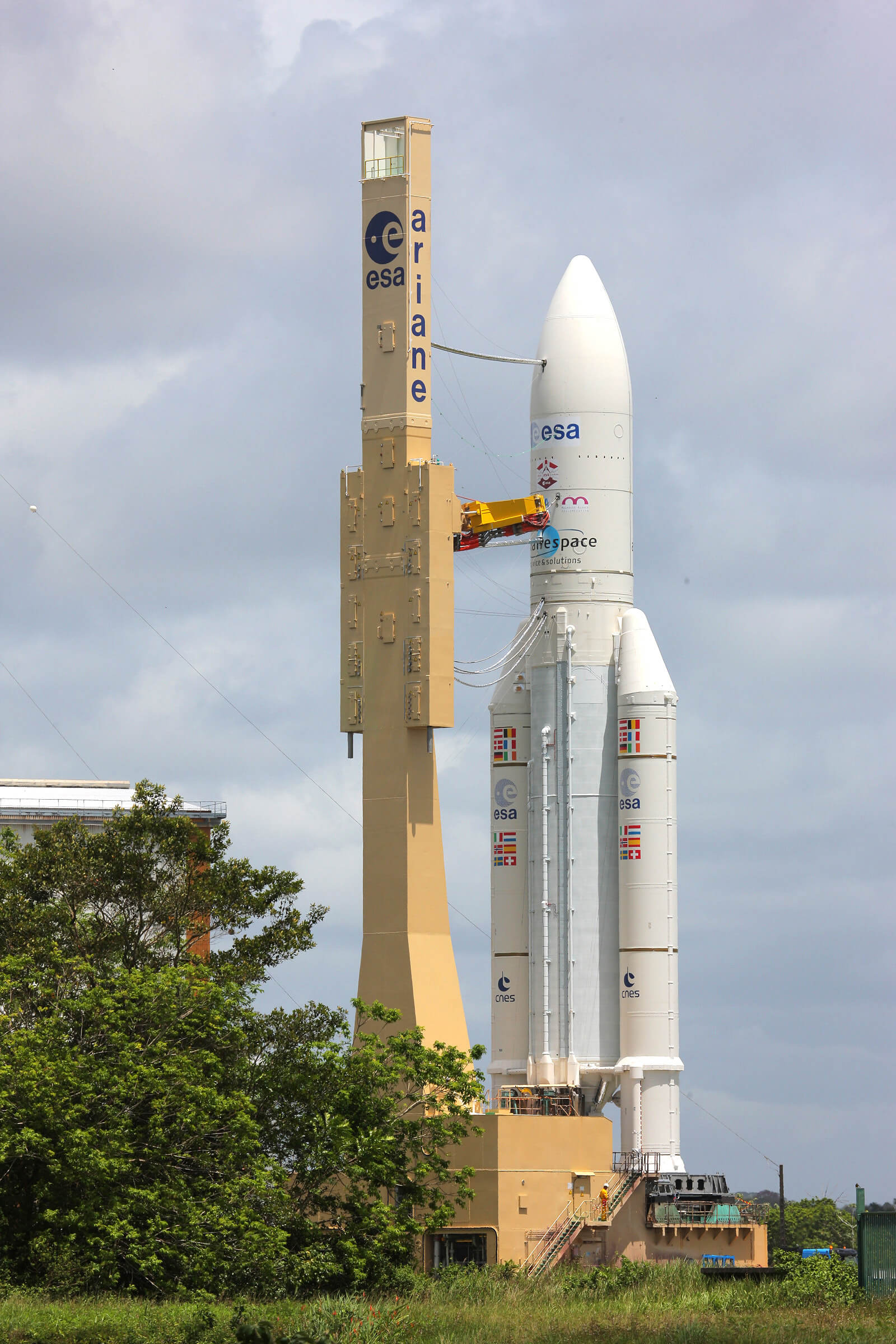
Russia abased its Buran programme in 1993, and NASA retired the Shuttle fleet in 2022, where by that point each mission was costing over 400 million dollars. However, satellite and space probe launches, along with trips to the International Space Station, have become routine, thanks to the many American, Russian, and European launch systems at present in operation. The expense is still astonishingly high, though, and all of the rocket platforms used remain not-reusable in any way.
Well, that was the case, up until two years ago.
A new race begins
On a pleasant Thursday evening, in March 30, 2022, a rocket was launched from Kennedy Space Centre Launch Circuitous 39, carrying a geostationary communications satellite.
Ii things were special about that launch and both were almost the rocket: first, the first stage had been used to launch something into space before and secondly, once it had deployed the satellite into orbit, the same stage returned to Globe and landed on a autonomous platform, merely off the declension of Florida in the Atlantic Ocean.
This was no elevation hole-and-corner armed services mission or an experimental machine from NASA; it was a Falcon 9 FT launch vehicle, designed and manufactured exclusively by SpaceX. This private organization, conceived and founded past Elon Musk using funds raised through earlier enterprises (Zip2 and 10.com, which eventually became PayPal), was barely 16 years old at the time.
SpaceX's offset rocket launch into low Earth orbit had taken identify but half-dozen years earlier and while it can be said that the company has stood on the shoulders of NASA and Russia, to paraphrase Isaac Newton somewhat, their pace of development and level of flight success has been meteoric.
Musk had set its sights on re-usability correct from the very beginning of SpaceX, to drive costs downward and maximize acquirement. But different NASA'southward arroyo for the solid fuel rocket boosters used in this Space Shuttle plan, the engineers at SpaceX envisioned a more radical approach.
The Shuttle's boosters were designed to provide the bulk of the launch thrust required and once ignited, they would burn down until almost empty. At that indicate, they would exist ejected abroad from the Shuttle, continue to burn until empty, and then complimentary fall back to Earth.
The boosters would and so deploy parachutes to slow the descent rate, before splashing down into the Atlantic Body of water. Bereft of fuel, they could float quite easily, so they would remain at the surface, until collected by a ship.
For SpaceX, this wasn't adept enough, especially since the Shuttle boosters needed to exist manually recovered and then required a meaning amount of work to be gear up for another launch.
What they wanted was a rocket that had engines with multiple capabilities (thrust vectoring, throttling, and a restart office were priorites) but without the costly servicing that the Shuttle's engines required.
They also wanted the rockets to fly themselves dorsum to Earth, landing on a construction such that they could exist recovered with the minimum of hands-on intervention.
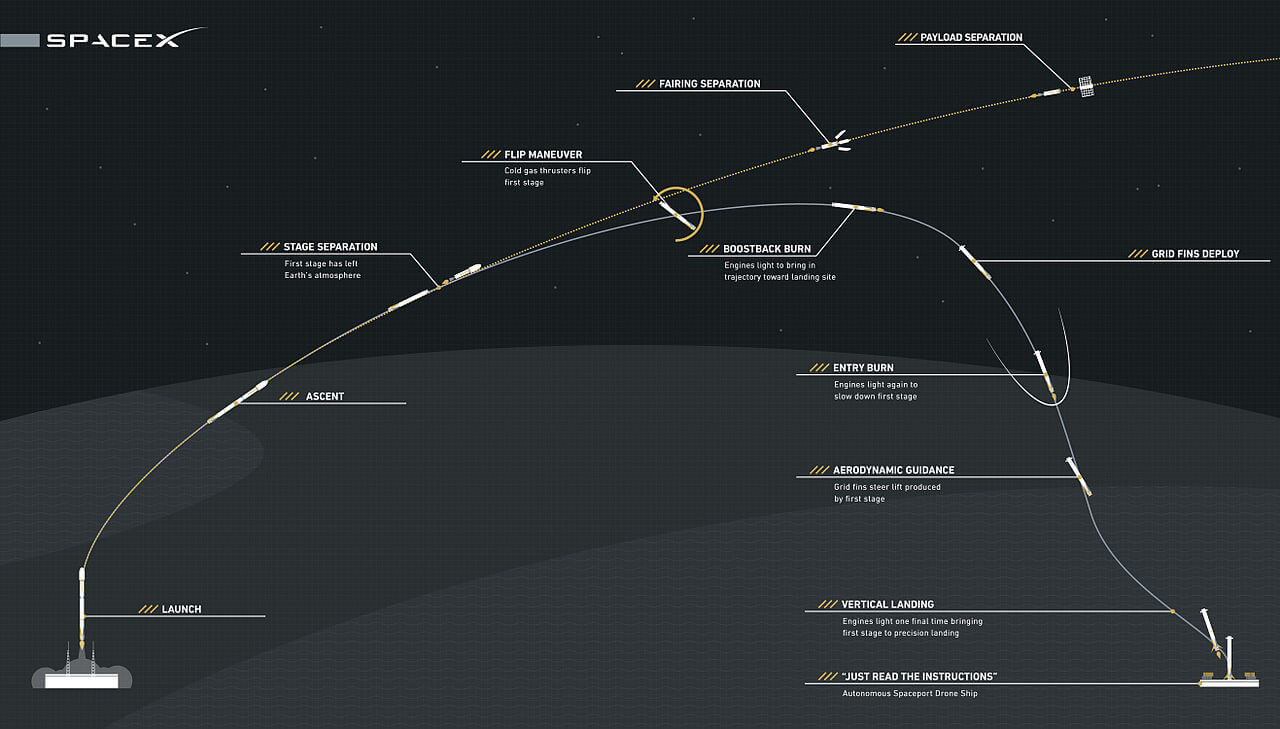
And then the Falcon rocket was built-in. Version 1 took its first flight in March 2006. Like so many attempts earlier it, the piddling Falcon i rocket failed merely 40 seconds into its maiden journey, impacting the ground a mere 250 feet away from where it had set off.
You lot could be forgiven for thinking that, subsequently 50 years of launches, the task of designing and building a new rocket would be a relatively straightforward process. Only space-worthy rockets are machines that tread a desperately thin line that separates them from existence classed as commercial vehicles or highly expensive explosive devices.
The design goals of Falcon, and indeed any rocket that can do the same feats, is very different to those that are in full general use. Y'all can get a sense of this by balancing a long pole on your fingertips -- to keep it upright, you'll demand to constantly move your paw about, although it'south easier if you constantly button upwards.
Once a normal rocket has reached its desired altitude -- achieving that through a constant balancing deed of upward thrust -- and deployed its payload, and so the flight is over. For a Falcon rocket, that's only half the journey: it needs to wing back to Earth.
The returning stage needs to be as light as possible and have aerodynamic control during the return trip. The Saturn Five rocket was essentially an aluminum blend construction, which was considered too heavy, so Falcon uses an aluminum-lithium alloy - this pick of material presents its ain difficulties, only its increased use in the unabridged aerospace industry has helped resolve the majority of them.
Control of the rocket during the return flying is managed through the apply of the main rocket, small thrusters, and aerodynamic grid fins as shown below.
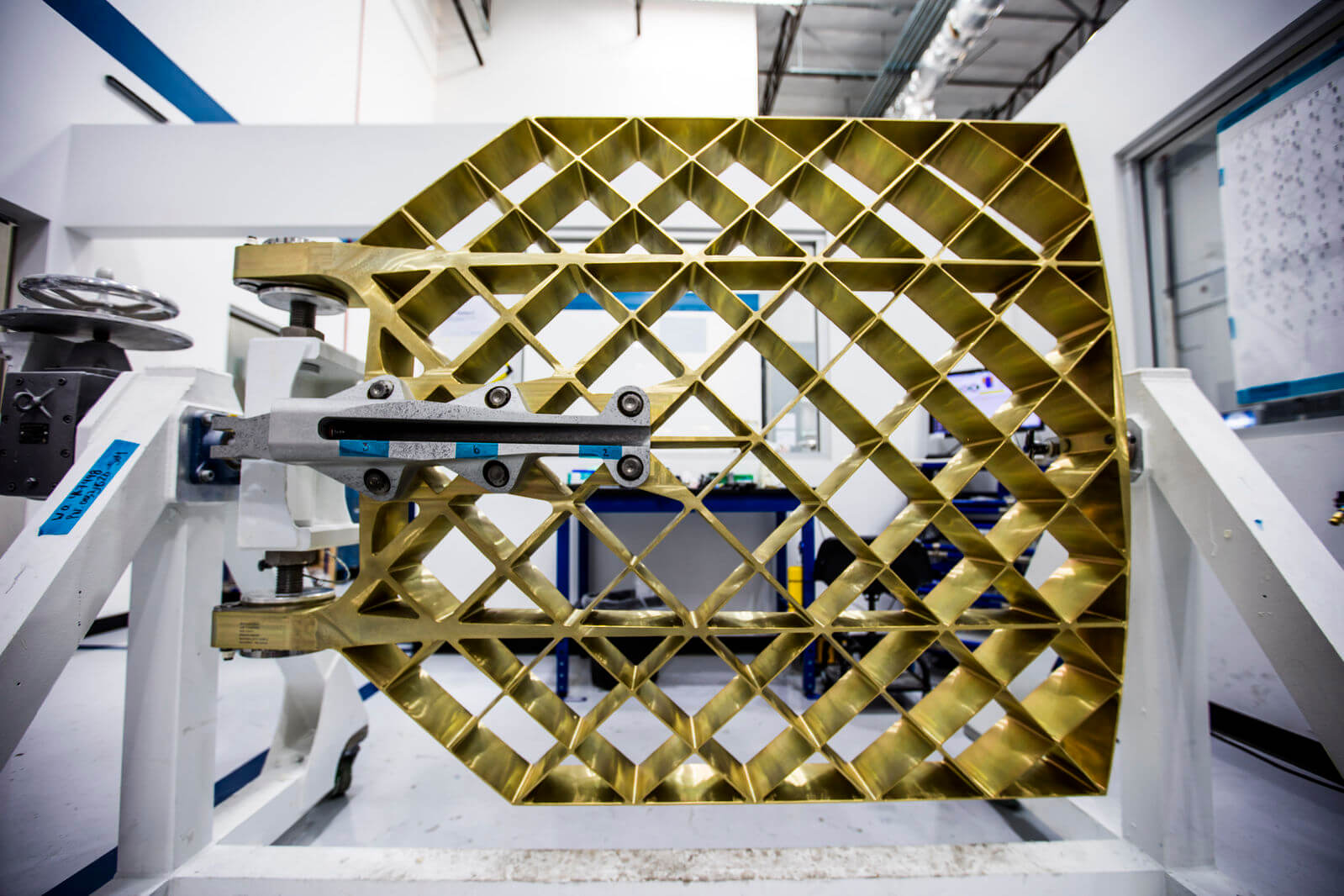
These are kept tucked abroad during launch, and then fold out when coming back down. Initially made from an aluminum blend, SpaceX switched to a titanium alloy, as they found that the earlier option only simply coped with the thermal stresses of supersonic flight through the atmosphere.
You can get a sense of what the return journey is like in this video from SpaceX, captured via an onboard camera, located at the very top of the rocket stage:
All of this is controlled by computer systems on the rockets. Given the speed and complexity of the landing, y'all'd be forgiven for thinking that bespoke, cutting edge technology is used here, likewise. While we don't know exactly what systems SpaceX are using, nosotros do know that the processors are dual core and x86 in nature, suggesting that the chips used are 'off-the-shelf'.
The computers run a Linux-based Os and use software developed entirely in house. They are also set up in multiple groups, to protect against problems acquired by radiations and hardware failure. Modern digital electronics are sensitive to ionizing radiation, and there are 2 ways to combat this: radiation hardening and radiation tolerant.
The quondam requires the chips to be uniquely manufactured in such a way that they are much thinner than their domestic cousins -- a thinner chip is less likely to absorb penetrating radiation than thicker ones, but the process forces restrictions on how complex the chip can be and adds considerably to the toll.
A radiation tolerant system skips this entirely, using iii sets of processors for every onboard computer system, and then if radiations affects the calculations of i of them, the other two volition produce identical results to each other just different to that affected past the radiations. The software picks this up and everything carries on accordingly.
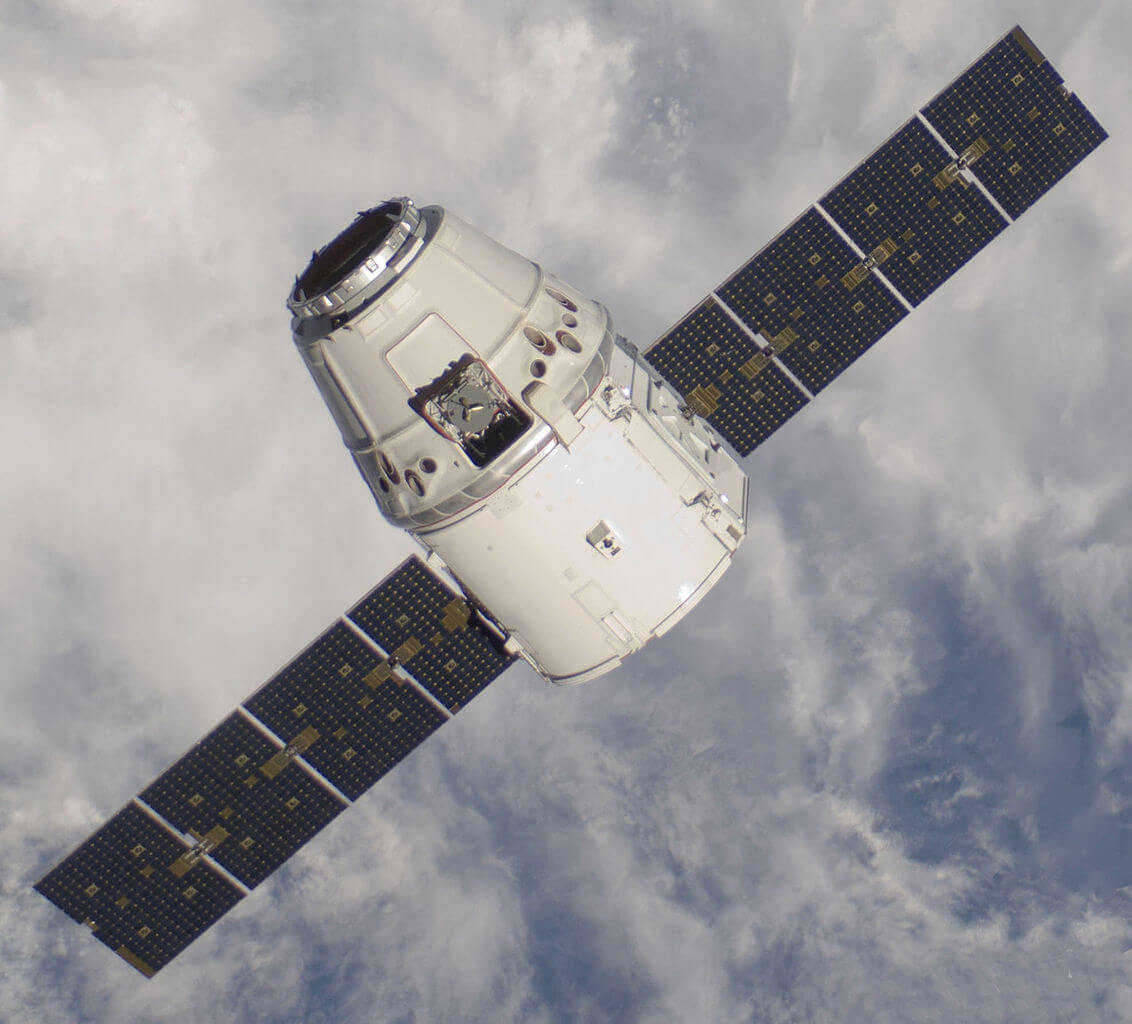
Where everything on the Saturn 5 rockets could be manually controlled, either via the crew or past ground control, all of SpaceX'south machines are designed to be fully autonomous - the merely fourth dimension humans step in is if something goes incorrect or they need to give final approval before an action commences.
This is the instance with the Dragon cargo vessel, when it comes to docking with the International Space Station. The whole flight is managed by the craft itself only it holds from the final docking maneuver until the ISS crew give the signal.

SpaceX has come a long way in 20 years and has shown that there is still lots more scope for the evolution of rockets.
There's more than one horse in this race
Elon Musk isn't the but James Bond villain lookalike that's loaded with cash and ambitions in space. Built-in to a full lack of fanfare, Blue Origin was formed past Amazon's Jeff Bezos in 2000 merely was launching test rockets of their ain design inside a mere 5 years of inception.
The two companies couldn't be more than dissimilar if they tried: SpaceX is ever ebullient, delighting in theatrics; Bluish Origin, on the other manus, has been far more secretive and cautious over the years. In total, SpaceX has accomplished over lxxx launches, whereas Blueish Origin has barely reached xi in a similar flow of fourth dimension.
SpaceX, however, is more than three times the size of Blue Origin in terms of staff, and despite the huge sums of coin Bezos has personally committed to the company, the smaller organization has received significantly less external investment and near no launch contracts. This hasn't stopped Bezos' team from exploring new technologies, especially when it comes to the rocket engines.
The various launch systems in use today generally utilize one of three fuel types:
- Cryogenic liquids, e.m hydrogen with oxygen or refined kerosene with oxygen
- Hypergolic liquids, e.thou hydrazine with nitrogen tetroxide
- Solid materials, e.g. aluminum with ammonium perchlorate, bound in butadiene
Each type has its own benefits and disadvantages, and analyzing these would be a full article in itself, simply Blue Origin have gone with a combination of liquefied natural gas (LNG) with liquid oxygen. This is the 2nd cleanest called-for fuel organisation, after liquid hydrogen, merely its main advantage is that the engine itself requires less complexity than the other liquid fueled systems.
This simplicity translates into lower costs and cheaper maintenance. SpaceX have stayed with a more traditional road, using refined kerosene, but despite the differences in their arroyo to rocket engines, the goals and design philosophies of the two companies - low price, reusable, democratic - are essentially the same. This is the polar opposite to the choices made by NASA for the successor to the Space Shuttle plan.
Named past a planning committee with no sense of what the word exciting ways, the Boeing-manufactured Space Launch System (SLS, for short) is very much Apollo reborn. Taking elements of the Space Shuttle launch organisation, such equally the main engines and booster rockets, NASA has designed what appears to be, at starting time sight, a carbon copy of the Saturn V rocket.

At the time of writing, NASA has however to launch a total size SLS organisation, with the first test mission not planned for another 1 to 2 years. If the parameters of the pattern are fully realized, then the SLS will be of the contenders for the crown for the largest, most powerful rocket in operation, but it volition have substantially the same lifting capabilities of the 50 twelvemonth former machine that sent mankind to the Moon.
The non-reusable nature of SLS, associated high mission costs, and construction delays have all drawn pregnant criticism from current and sometime NASA administrators, though. Part of the source of these issues is due to the fact that NASA is publicly funded through taxes, allowing diverse politicians to press for the system to apply companies that employ people in u.s.a. they represent. Some other factor involves going back to the Moon, but we'll say more than nigh that in a moment.
The Infinite Launch Arrangement isn't the only actor in the heavy lifting field of rockets; both SpaceX and Blue Origin have designs that, if fully realized, are either similar in concrete size to SLS or exceed its lifting capabilities.
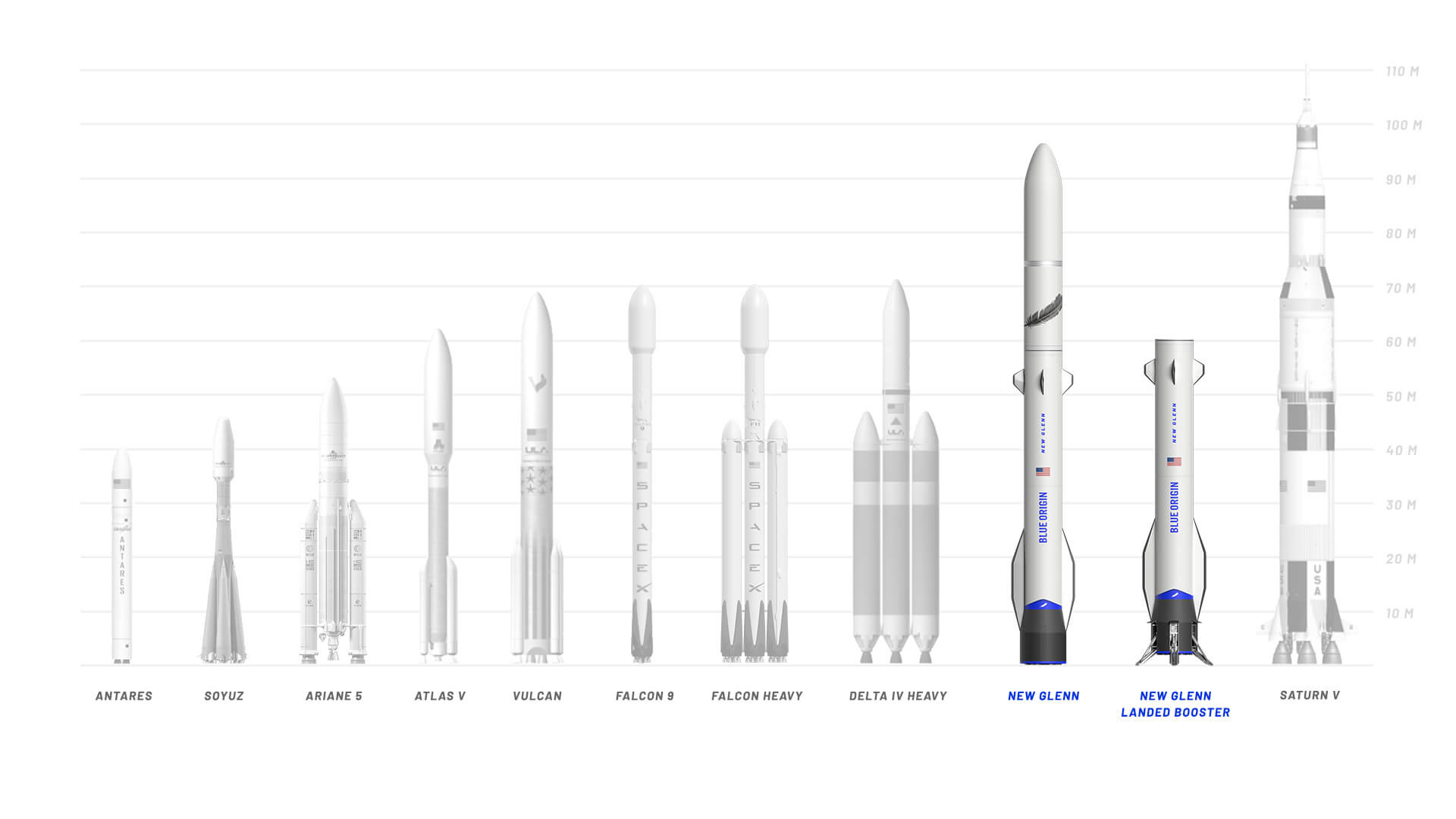
There are two chief reasons for all these manufacturers pushing for massive rockets, capable of lifting well-nigh 100,000 pounds (around 45 metric tons) into Low Globe Orbit. The kickoff is simple: at that place isn't anything out there since the Saturn V that can handle anything similar these loads. The Space Shuttle was rated to 54,000 pounds (roughly 24 metric tons) and Lockheed Martin/Boeing's Delta V Heavy tin move merely 8,000 pounds more than. SpaceX's Falcon Heavy rocket is theoretically capable of considerably more, but has yet to be tested with a payload greater than 14,000 pounds (6 metric tons).
Simply this still doesn't answer the central question of why nosotros demand a rocket capable of lifting a bigger payload. Why does NASA need SLS to accept the capability of putting 230,000 pounds into orbit?
Aiming for the moon (again)
In 2005, the Us Congress signed in an act that authorized NASA to commence the then-called Constellation program. It's aim was to develop a replacement for the Infinite Shuttle such that the International Space Station evolution could be continued and provide a new platform for manned missions to the Moon again. The whole matter was promptly unsigned, simply v years later, when the true size of the costs became apparent.
A render to the Moon has been a repeated indicate of hot debate, e'er since Apollo 17 left the 'beautiful pathos' dorsum in 1972. Scientists and former Apollo astronauts take continually expressed dismay over the lack of homo space exploration beyond Depression Earth Orbit; politicians and economists have e'er countered such complaints with the same response: we can't afford it.
NASA didn't accept the closure of Constellation lightly. Many of its elements were almost immediately recycled into a new plan (SLS), along with a rough idea for some other infinite station; the latter wasn't to be a replacement for ISS though. Initially called the Deep Space Habitat, information technology was conceived to be a gateway to lunar exploration and beyond, and designed to exist kept in orbit effectually the Moon, not Globe.
By 2022, things had changed (over again) - a new Us president was in power, who was rather keen on space projects, and a certain Elon Musk announced that his company had plans to colonize Mars. As it turned out, neither were vacuous promises, equally within a year, Space Policy Directive 1 was announced (with a rather grumpy looking Fizz Aldrin in tow) and Musk provided more than details, including primal rocket designs and the programme for how to pay for it.
Earlier this year, NASA renamed their manned mission program Artemis and confirmed a date for the Moon.
The promotional video for the Artemis programme is light on details -- SLS nosotros already know about is in construction, only a full test flying has still to take identify; a test Orion capsule has been built, launched into space on tiptop of a Delta Half dozen rocket, and it returned safely to Earth.
However, Gateway (essentially Deep Space Habitat rebranded) has barely started, does not have the design, nor has a manufacturer for the lunar lander been decided upon. The technology required to do this already exists, but politics and coin are influencing its rate of progress. Thus there'south a healthy dose of skepticism over NASA even getting to the Moon, let lone landing on it once again, by 2024.
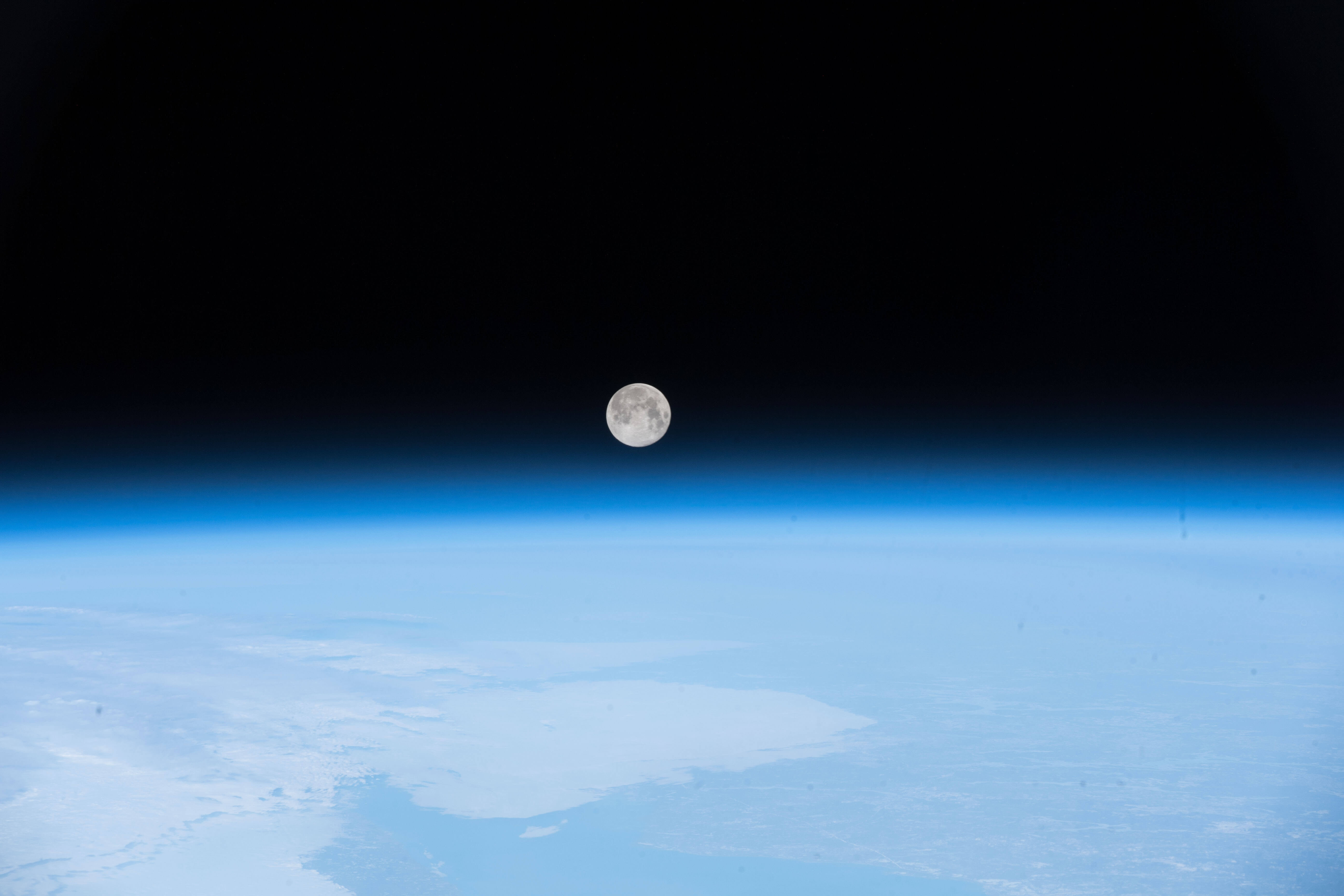
However, if we go back to 1964, five years before Neil and Fizz set pes on the Moon, the race to the Moon was in a similar state. The Apollo program had already begun, simply no Saturn Five rocket was ready and NASA was all the same battling with orbital rendezvous bug in the Gemini program. It would be some other 4 years before humans were put in orbit around the Moon, in the Apollo 8 mission.
While NASA no longer enjoys the funding and manpower information technology experienced five decades ago, there are far more companies bachelor to take blueprint and manufacturing contracts -- a total of eleven have so far been registered to develop lunar landing systems (complete and partial components) for consideration.
Blue Origin has already designed a lunar lander that has greater capabilities that the original LEM and plan to apply variants of information technology in missions other than only Artemis. SpaceX is one of those eleven companies, only they likewise plan to send a tourist around the Moon, as part of an fine art project called #dearMoon.
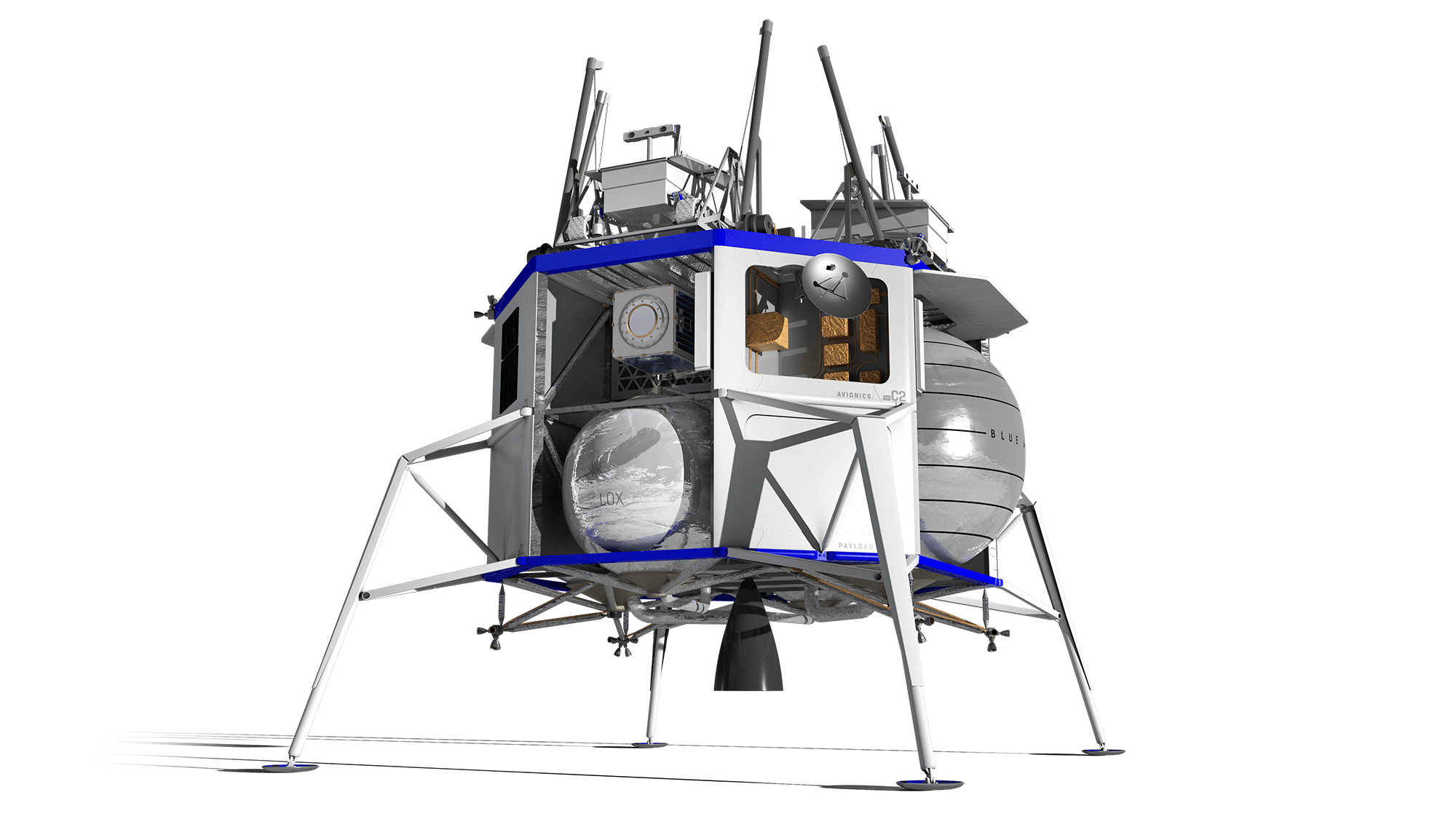
And there'south another reason why a lunar landing may just accept identify in 2024: there'south a bigger prize at pale.
Going all out for Mars
As mentioned earlier in this article, Elon Musk is expressionless gear up on going to Mars (he's even been clear on what he means by 'dead', likewise) and to do this, SpaceX is in the process of developing two new machines: a reusable launch rocket chosen Super Heavy (previous called Big Falcon Rocket) and a Shuttle-esque spacecraft chosen Starship.
Together they look similar something direct out of a sci-fi motion picture and while the final product might not exist quite so pristine and shiny, the Californian company is fully committed to the project.
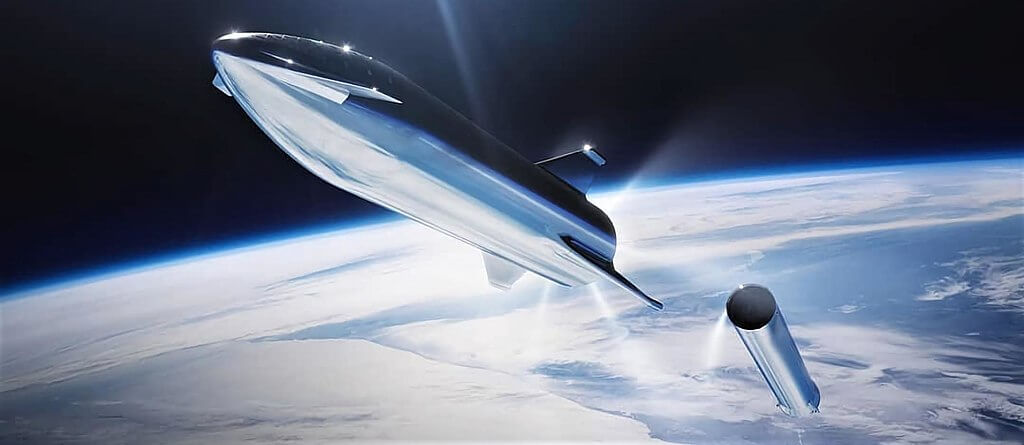
Y'all might wonder why a vessel designed for spaceflight has wings, albeit rather modest ones, simply they're not for flying nigh on Mars -- they're for aerobraking on entry. Starship volition really state vertically, whether on Earth or Mars, using systems like to those found in the Falcon serial of rockets.
SpaceX has set no firm dates for reaching Mars and other than agreements with investors, they're under no political pressure to achieve such a goal within a given time frame. For NASA, it'south a little different. They are using the Artemis plan to develop systems and structures that can exist put into identify, before any attempt can exist made at sending humans to the distant, little planet.
Yet, the Moon program is clearly being sold every bit a precursor to Mars and the latter is even being used to forge commercial partnerships and strengthen political alliances.

Although administrations come up and go, NASA volition be under pressure to deliver Artemis on time and brand good progress in all the various programs that need to be conducted in order to carry a manned mission to Mars.
Only if Artemis is a success, and we do run into humans walking on the surface of the Moon once more by the end of the adjacent decade, then is a trip to Mars is guaranteed?
The chasm to leap
Sending humans to Mars and bringing them back home is a job that makes going to the Moon look like an afternoon jaunt to the beach. The starting time hurdle is a simple one: distance. At their closest, Earth and Mars are roughly 35 1000000 miles (56 million km) apart, which is almost 150 times greater than the average gap between Earth and the Moon.
For the Apollo missions, the journeying between the rocky bodies took around 4 days; bold the speeds are the same, going to Mars would have 600 days or 1.5 years.
The longest amount of time any human has spent in space is 438 days, by Valeri Polyakov on board the Russian Mir infinite station. The long term effects of living in micro gravity environments have been studied in depth over the years, and despite measures to combat loss of bone density, changes to cistron and cognitive behavior, there is no escaping the fact that humans spending over a twelvemonth in space travelling to Mars, will not be in an ideal state to conduct missions on the surface of the planet.
It takes months of rehabilitation to adjust on Earth subsequently a typical six-calendar month space mission
Information technology's worth begetting in mind that the 600 twenty-four hour period journey in space would need to be washed twice (there and back), and during this time, the planets continue to move, and so Mars and Earth are at their closest every 2 years.

So the actual altitude to cover will exist more than 35 million miles and the crew volition need to spend a few months on Mars, to provide time for the planets to realign back to a minimum separation. The longest period of time spent on the Moon was 3 days, by Eugene Cernan and Harrison Schmitt in the Apollo 17 mission.
Ane obvious solution to this is to increase the speed of the craft taking the crew to Mars. Apollo 10 currently holds the record for the fastest manned vehicle, peaking at only under 24,800 mph (39,900 km/h), and at that speed, the trip to Mars would only take a couple of months. However, the gravitational pull of the Earth was responsible for this, and trips to Mars aren't going to be able to employ this gratis ride.
The next large claiming is related to the first one, in that whatsoever humans on Mars will accept to solve pretty much every serious problem by themselves. The quickest whatsoever radio signal can reach the little planet is but over 3 minutes (during minimum separation) only tin can accept up to 22 minutes, and that'due south just 1 mode.
So there's no risk of simply 'Googling' a solution or conversing with mission control in real-time, unlike with the Apollo missions where contact with an engineer on Globe was never more than than a couple of seconds. That means every applied science and medical issue that arises will require a suitable good to paw, but what happens if that expert falls ill or is incapacitated in some mode?
To address this will virtually certainly require the crew to be knowledgeable and talented into multiple areas, backed up with digital guides and documents. The men that flew in the Apollo missions were trained in as many areas every bit possible, merely they also had the advantage that NASA was but a 2nd or two abroad.
Where and what else is possible?
Mars and the Moon aren't the only goals in this new infinite race. Good old fashion tourism is right in the mix, even though it has been possible to 'merely' buy a ticket for a journey to space for some time now.
In April 2001, Dennis Tito became the outset infinite tourist in history, spending a calendar week on the International Space Station, having paid the Russian Federal Infinite Agency an undisclosed sum of money for the training, identify on the Soyuz rocket, and time on the ISS. While the figure paid is unknown, one reported estimate put it at $20 million.
That's clearly mode across the means of almost everyone, fifty-fifty those who would be deemed to be 'well off' by global standards. Only it hasn't stopped a number of companies setting along to conquer such high risk ventures, with the most notable being Richard Branson's Virgin Galactic.
Despite the name, the intended journey is only a cursory flirtation with the edge of space. The spacecraft, bristling with blended materials and powered by a liquid fuel rocket, gets dropped from a bespoke heavy-lifting plane at an altitude of 50,000 feet (15 km) and then powers on up to the Kármán line at 62 miles (100 km).
At that place, the coiffure and passengers experience a number of minutes of micro-g (i.e. floating around), before gliding back to Earth.
The project was unveiled in 2009, with initial ticket prices set at $200,000; around 300 people had plain booked a place, fifty-fifty though they were told that it would 3 years until everything was ready.
Information technology never was and the venture has yet to accomplish its goals, peculiarly due to the setback in 2022 when a test flight went seriously wrong (resulting in the death of i crew member, and heavily injuring the other).

SpaceX and Blue Origin are also interested in taking people for a boom into space, with the latter taking orders for flights on its New Shephard rocket for a quick boom to the Kármán line.
The above prototype shows how SpaceX envisions how the interior of the crew capsule of their Dragon craft might expect similar -- the clinical nature and about full lack of instrumentation reflects the nature of how the craft functions and the nature of the crew, i.eastward. they're not required to fly information technology nor take whatsoever control over it. The same is true for Blueish Origin's sheathing (below):
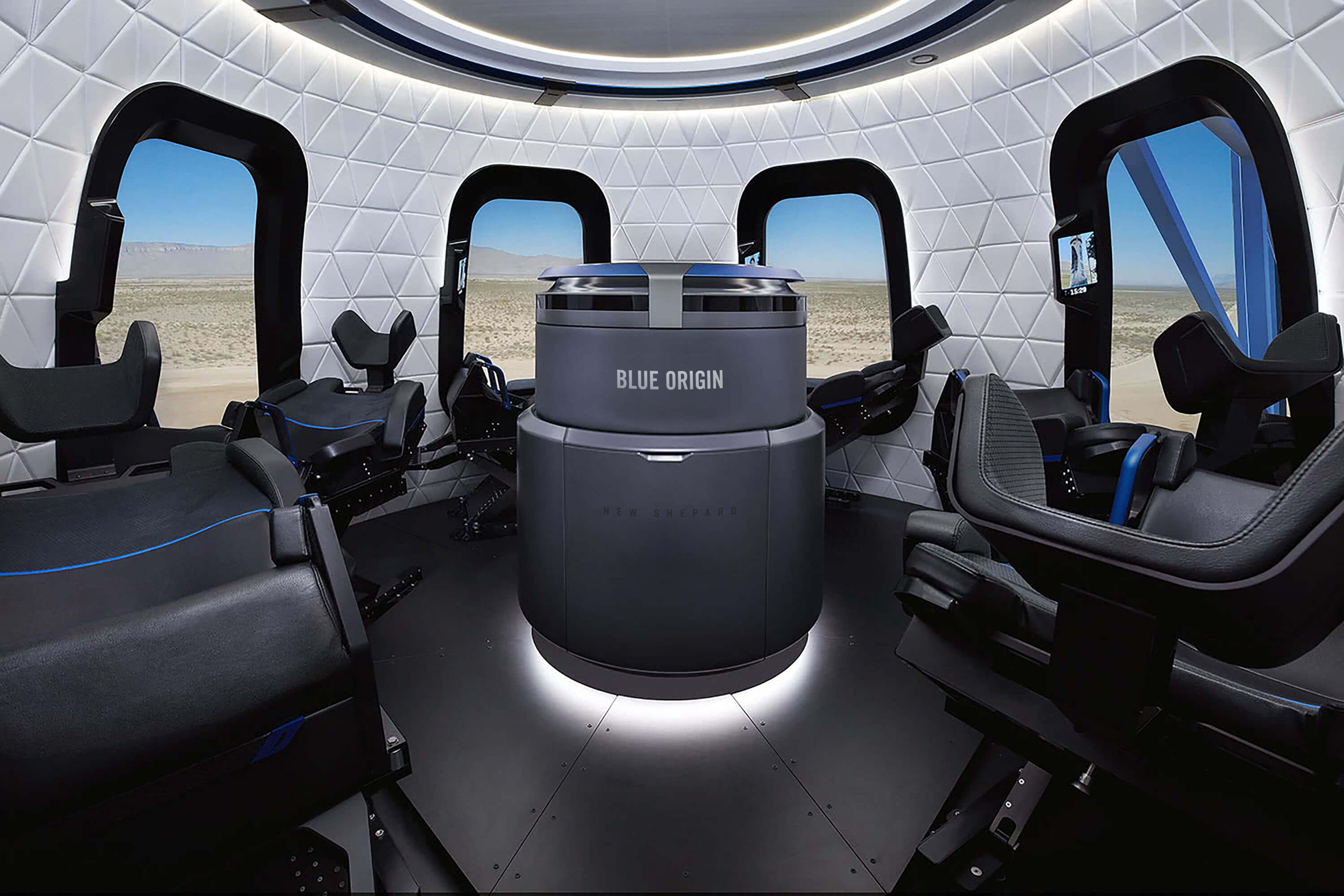
A careful look at both images volition bear witness y'all how the choice of materials has changed since the days of Apollo. Common cold metal panels, all painted military grey, are out; composite polymers and carbon fiber are in. The manufacturing costs of these accept fallen dramatically in by decade or so, permitting a far more liberal apply of them.
The benefit of this is, of grade, weight saving and for every pound shaved off the spacecraft and launcher, the less fuel is needs to get into space and the cheaper and faster the whole flight becomes. One exception to this is SpaceX's Starship, which is expected to exist constructed mostly out of steel alloys, despite the significant weight problem.
The reason given for this is that Starship is a much larger cargo/passenger arts and crafts than Dragon and at its size, the use of carbon fiber composites for the entire craft would be an unacceptable increment in cost to the program.
Space tourism is very much on the cusp of becoming affordable, although this term really merely applies to millionaires. Just there's money to exist made elsewhere in space, in this new race, and it tin can exist found in the form of huge lumps of rock, metal, and ice orbiting the Sun -- otherwise known every bit asteroids.
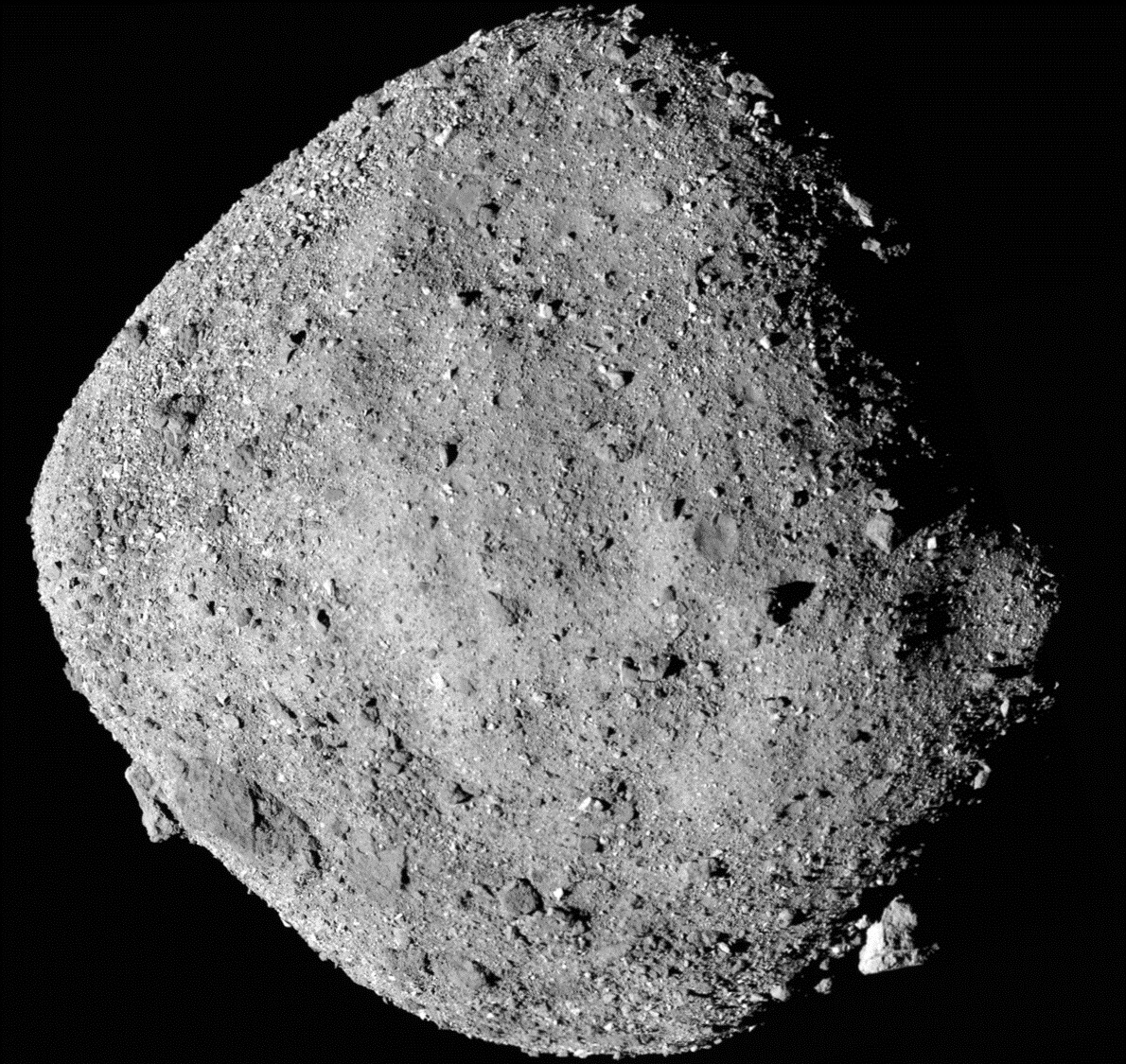
These are essentially leftovers from the early days of our solar arrangement -- scraps of matter that didn't coalesce with the rest to form planets. They come up in all kinds of shapes and sizes; a few are the size of a small planet (e.chiliad. Ceres), but the majority are barely big enough to concord together under their own gravity.
One such example is a carbonaceous asteroid chosen 101955 Bennu. At that place's nil particularly special well-nigh it, when compared to the millions of other asteroids out there, just this one simply happens to orbit the Sunday reasonably close to World; it's also around 1600 feet (488 chiliad) in bore, with an average density like to that of water.
For those two reasons, NASA launched a infinite probe to it, 3 years ago, named OSIRIS-Rex. The mission goals were simple: become to the asteroid, put the probe in orbit effectually it, collect a sample of the asteroid itself, and return the material to Earth for analysis.
The asteroid's proximity to united states meant that it could be reached relatively quickly and it's minor size ensured that retrieving a sample wouldn't require the use of a lander or drill. The nerveless pieces are scheduled for touchdown on Globe in December 2023, and scientists will be able to get a look at matter older than our planet.
And so how exactly is this an opportunity for concern? The OSIRIS-Male monarch mission is one of the first steps needed for the mining of asteroids, many of which are known to be rich in metals, to become a commercial reality.
In that location are huge financial and technological hurdles to overcome; the kickoff of which requires spaceflights to go far cheaper than they currently are, and this is where companies such every bit SpaceX and Blue Origin come in, with their reusable launch systems.
We're certainly decades, maybe hundreds of years, away from seeing asteroids replacing the Earth as being the source for all rare metals and minerals, merely don't forget that the get-go powered flying by mankind took place at the beginning of the 20th century. It took less than 7 decades to get from Orville Wright's 12 second flight into the history books to driving electrical buggies and playing golf game on the Moon.
What to make of this infinite race?
This new infinite race is cipher similar the terminal i. There is no superpower cold war driving urgency and funds into information technology. Promises of returning to the Moon or sending humans to Mars aren't new either, so these can't be used as the reason for the race existing.
And yet, there is a race. It'due south non a frantic dart, though; this 1 is more alike to a marathon, and its competitors, bristling with ambition and no small amount of money behind them, are in for the whole distance. This is because there are clear financial incentives: rocket launches are becoming ever more cost effective and there are thousands of individuals and corporations willing to invest in space ventures.
There is an estimated 20 times more than millionaires in the United states of america alone, compared to the 1960s, and while this growth in individual wealth is partly due to the decrease in the value of the dollar, globalization and the spread of capitalism have besides played their part. Where the notion of being a space tourist used to be zippo more than a flight of fancy, the hazard of becoming a private astronaut is now very much a real thing.
The Apollo program helped generate and so much new technology that we're still feeling the benefits of it, 50 years later. And then will this new space race do the same again; will computers and materials of the near future owe their being to Musk, Bezos, et al? Probably not. Despite all the funds that SpaceX and Blue Origin have taken in, they're still spring past the same limits. Space flight and human being exploration of other worlds has to be affordable; resources can't exist wasted. Apollo had no such constraints in its heyday and flew on a Saturn Five of progress and development, the likes nosotros'll probably never see again.
This new race is nether way, with the start line now just a retention. Just the Moon is still waiting for new people to take their ain small pace and giant leap, and Mars must look even longer. They will wait, just equally they have always done, and one day -- five or fifty years from now -- a new generation will watch these landings, and dream of running in their race, too.
Source: https://www.techspot.com/article/1895-tech-space-race/
Posted by: woodplecepeave61.blogspot.com


0 Response to "The Moon, Mars and Beyond: The Tech Behind the New Space Race"
Post a Comment